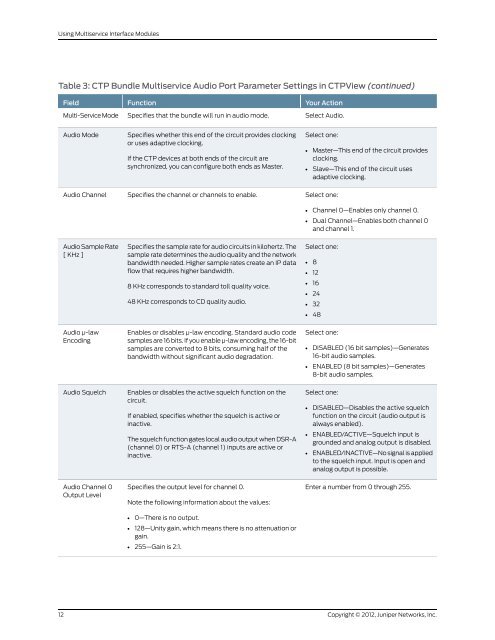Using Multiservice Interface Modules - Juniper Networks
Using Multiservice Interface Modules - Juniper Networks
Using Multiservice Interface Modules - Juniper Networks
Create successful ePaper yourself
Turn your PDF publications into a flip-book with our unique Google optimized e-Paper software.
<strong>Using</strong> <strong>Multiservice</strong> <strong>Interface</strong> <strong>Modules</strong><br />
Table 3: CTP Bundle <strong>Multiservice</strong> Audio Port Parameter Settings in CTPView (continued)<br />
12<br />
Field<br />
Multi-Service Mode<br />
Audio Mode<br />
Audio Channel<br />
Audio Sample Rate<br />
[ KHz ]<br />
Audio μ-law<br />
Encoding<br />
Audio Squelch<br />
Audio Channel 0<br />
Output Level<br />
Function<br />
Specifies that the bundle will run in audio mode.<br />
Specifies whether this end of the circuit provides clocking<br />
or uses adaptive clocking.<br />
If the CTP devices at both ends of the circuit are<br />
synchronized, you can configure both ends as Master.<br />
Specifies the channel or channels to enable.<br />
Specifies the sample rate for audio circuits in kilohertz. The<br />
sample rate determines the audio quality and the network<br />
bandwidth needed. Higher sample rates create an IP data<br />
flow that requires higher bandwidth.<br />
8 KHz corresponds to standard toll quality voice.<br />
48 KHz corresponds to CD quality audio.<br />
Enables or disables μ-law encoding. Standard audio code<br />
samples are 16 bits. If you enable μ-law encoding, the 16-bit<br />
samples are converted to 8 bits, consuming half of the<br />
bandwidth without significant audio degradation.<br />
Enables or disables the active squelch function on the<br />
circuit.<br />
If enabled, specifies whether the squelch is active or<br />
inactive.<br />
The squelch function gates local audio output when DSR-A<br />
(channel 0) or RTS-A (channel 1) inputs are active or<br />
inactive.<br />
Specifies the output level for channel 0.<br />
Note the following information about the values:<br />
• 0—There is no output.<br />
• 128—Unity gain, which means there is no attenuation or<br />
gain.<br />
• 255—Gain is 2:1.<br />
Your Action<br />
Select Audio.<br />
Select one:<br />
• Master—This end of the circuit provides<br />
clocking.<br />
• Slave—This end of the circuit uses<br />
adaptive clocking.<br />
Select one:<br />
• Channel 0—Enables only channel 0.<br />
• Dual Channel—Enables both channel 0<br />
and channel 1.<br />
Select one:<br />
• 8<br />
• 12<br />
• 16<br />
• 24<br />
• 32<br />
• 48<br />
Select one:<br />
• DISABLED (16 bit samples)—Generates<br />
16-bit audio samples.<br />
• ENABLED (8 bit samples)—Generates<br />
8-bit audio samples.<br />
Select one:<br />
• DISABLED—Disables the active squelch<br />
function on the circuit (audio output is<br />
always enabled).<br />
• ENABLED/ACTIVE—Squelch input is<br />
grounded and analog output is disabled.<br />
• ENABLED/INACTIVE—No signal is applied<br />
to the squelch input. Input is open and<br />
analog output is possible.<br />
Enter a number from 0 through 255.<br />
Copyright © 2012, <strong>Juniper</strong> <strong>Networks</strong>, Inc.
















